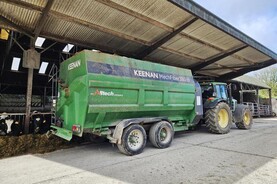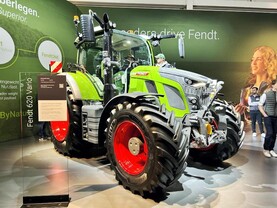Lloyd Forbes is based near Carrigaline in county Cork. The majority of his work is for the concentration of dairy farmers in his locality where dairy herds are getting larger, demanding more grass and maize silage to feed them.
Pit, baled and maize silage keeps Lloyd busy for a lot of the year with slurry spreading and zero-grazing among the many other jobs he does on contract. I met Lloyd in a good standing crop of maize on the outskirts of Cork city and began by asking him why he changed from the previous machine.
“I was operating a 10-year-old John Deere 7700 forage harvester until the end of the first cut 2016. It was time to change as keeping it any longer was going to cost a lot of money and in this business reliability is key.
“I looked at Krone and there was a significant difference in money but I stuck with John Deere. The 7700 went very well and my brother is a John Deere mechanic so it was going to be hard to change brands. This machine landed after that on 20 June 2016.”
In a typical year, Lloyd is getting through approximately 2,300 acres of silage, the acerage of which is growing like the cow herds around him, 350-400 acres of maize and makes roughly 17,000 bales of silage with two Welger balers. He’s a busy man.
Cab comforts
Sitting into the large cab, the first thing I noticed was how quiet it was. Despite the six-cylinder 13.5l Powertech engine at full revs behind us, we didn’t have to shout over the smooth consistent hum of the drum beneath us.
Lloyd was operating a six-row Kemper maize head and chopping to 12mm. He did admit an eight-row head would be a lot more suitable but this was fine for the 350+ acres of maize he was harvesting.
“A wider header would be great but that’s another big spend on a machine that is only used for a few weeks of the year.”
I asked him what the biggest differences between the 8600i and his 7700 were.
“The pick-up drive is miles ahead of the older machine. Previously when grass was tedded out and raked in, lumps in the sward were a nightmare to pick up. It’s no longer an issue as the head speed is matched to the speed of the machine meaning as you increase forward speed so does the pick-up speed.
“The grass pick-up feeds a lot better and we’ve only had one knife knocked back since we got the harvester thanks to the quick stop system that stops stones getting to the drum. In the last harvester, we would have opened the chopping cylinder every few days.”
Lloyd is using a 30ft rake for silage but admits a wider 40ft rake would have two benefits.
“If we could bring in 40ft of silage we’d get more output from the harvester and drive slower, saving hopping around in bumpy fields”.
Output and diesel
Like all forage harvesters, they burn diesel and lots of it. This is especially apparent in maize due to the added load of having to crush everything between the rollers in the corn cracker. Lloyd is pleased with what diesel his harvester is using.
“Last week, we were harvesting a 25t/ac crop. Over the 40 acres, it used 600 litres, which equates to 1.66l/t of harvested material. This includes the harvester running idle waiting for trailers. Output in grass or maize is dictated by a lot of things, including field size, length of draw and crop yield.
“The best day’s output was 190 acres of first-cut silage in four different yards with all pits covered along the way which is pretty good going. We all slept well that night.”
I asked what was it like compared to the 7700 on diesel seeing as it’s also using Ad-Blue.
“It burns about the same and is very light on Ad-Blue. I bought 1,000l of Ad-Blue at the start of the year and there’s still a lot of it left to use. The only nuisance is when you have to wait for the engine exhaust system to regenerate. This can take a good few minutes, which all count when the pressure is on. The big difference is we’re probably getting 10-15% more output from the harvester using about the same amount of fuel. To make sure the machine is running as efficiently as possible, I sharpen the knives three times per day.”
Speaking of knives, Lloyd is using 36 knives in grass to get more through the machine.
“Increasing the number of knives and feed-roller speed has meant we can get more through the harvester without compromising chop length.”
On maize, Lloyd is using low-volume additive. “It’s a great job as the tank can hold 30l and it’s only 0.5l/ac. It saves topping up every few hours with the high-volume pump which is fitted to the machine but I don’t use it.”
Other useful features on the machine are a fold-out area for a toolbox and spares at the rear of the machine and a compressor, useful for cleaning the radiator or pumping up a tyre.
Reliability
With almost two seasons under his belt, I asked Lloyd has he had any issues. “The air-con stopped working and an oil seal went which we spotted before we had any trouble. Otherwise, it has been really reliable and long may it continue.”
The future
Lloyd sees the price of machinery being the biggest challenge in the short term.
“Any decent tractor you buy over 140hp with a good level of spec is crazy money. If contractors are going to stay in business, the prices they charge will have to increase. This is to cover the costs of the new machinery which you must have, as reliability and being there when you say you will, is vital. As it is, margins are tight and only getting tighter.”
I asked him had he any plans to change how he is doing what he doing.
Mower
“I have a BiG-M self-propelled mower but will look into replacing it with a tractor and triple mowers. It’s a fantastic machine but is costing a lot to sit idle for so long. If I had a tractor and mowers I could make use of the tractor throughout the year on other jobs.
“I also bought a Belair zero-grazer which we’re really busy with. Third-cut silage is no good in bales as they just sag so customers are bringing it in and feeding it to the cows which works well. Whatever happens in the future, Lloyd has built a strong business covering all silage-bases with his various means of getting it from field to cow.






 This is a subscriber-only article
This is a subscriber-only article











SHARING OPTIONS: